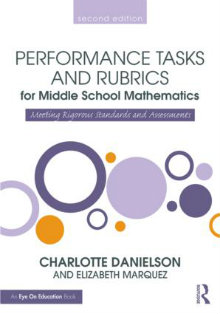Performance Tasks and Rubrics for MS Math
Performance Tasks and Rubrics for Middle School Mathematics: Meeting Rigorous Standards and Assessments (2nd Edition)
By Charlotte Danielson and Elizabeth Marquez
(Routledge/Eye On Education, 2016 – Learn more)

Maybe you have tried some of the performance task items provided by a testing consortia in your classroom but feel ill-prepared to use these to their full potential for instruction and assessment. Perhaps you are looking for a way to increase the Depth of Knowledge levels of your instruction and assessment.

They intersperse ideas for professional development activities, strongly suggesting that the development, implementation and scoring of performance tasks is best done in collaboration with colleagues.
More than half of the pages in this book are dedicated to actual performance tasks with accompanying rubrics and student work. (The tasks themselves can be downloaded under the e-resource tab at the publisher’s site here.)
Clarifying rubric use for math
As someone who has worked on multidisciplinary teams in both middle and high school, I have certainly adapted rubrics from other subject areas to mathematics, but this process has yielded mixed results. This book clarifies how a rubric can be used for non-traditional math assessments and precisely how to design it to meet your needs.
The authors also suggest ways to clarify whether a performance task is being used for formative or summative purposes and include additional suggestions for teachers who are new to using performance tasks.
A concise book that saves teachers time and energy
I have stumbled across much of the information in this book by trial and error, during various workshops and collaborations in my school district. However, it was extremely validating to read the authors’ concise layout of how to make performance tasks useful to teachers, students and families. Had I read this 10 years ago, I might have saved myself a lot of energy.
This book would be a great resource for any math teacher or group of teachers looking to work on improving their assessments and thereby improving the instruction leading up to these assessments.
Jan Roberts, M.Ed., has been a mathematics teacher in southern New Hampshire for grades 5 -12 for over 20 years. She has presented workshops in her district and state and at a national ASCD conference on topics such as freshman teaming, problem-based learning and the concrete, and visual and abstract progression for mathematics instruction. When not at work, she loves being in the great outdoors of New Hampshire.

































